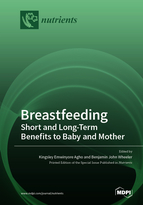Breastfeeding: Short and Long-Term Benefits to Baby and Mother
A special issue of Nutrients (ISSN 2072-6643).
Deadline for manuscript submissions: closed (30 September 2019) | Viewed by 109714
Special Issue Editors
Interests: biostatistics; maternal and child health; feeding practices; epidemiology; public health
Special Issues, Collections and Topics in MDPI journals
Interests: early life nutrition; vitamin D and bone health during pregnancy, lactation, and infancy; new technologies for children and young people affected by diabetes; factors that impact on glycaemic control in diabetes
Special Issue Information
Dear Colleagues,
Breastfeeding is the preferred method of feeding in early life. It is also one of the most cost-effective childhood survival interventions. Breastfeeding practices are important for preventing child mortality, and morbidity, as well as ensuring the optimal growth, health, and development of infants. The public health benefits of breastfeeding have been well documented in the medical literature, and include the following: associations with decreased risk for early-life diseases such as otitis media, respiratory tract infection, diarrhoea, and early childhood obesity (to name but a few).
In the late 1990’s, The Baby Friendly Hospital Initiative (BFHI), based on appropriate training and a system of hospital accreditation, was introduced and has proven to be an effective health systems approach to improving breastfeeding outcomes. Since the introduction of the BFHI approach, breastfeeding has improved mothers' health because breastfeeding practices burn extra calories, which could help mothers to lose pregnancy weight faster and lower the risk of developing heart disease, breast, and ovarian cancer. Breastfeeding also improves mothers' emotional health, and plays an important role in child spacing, which strongly correlates with improved maternal and child survival and health.
In 2008, The World Health Organization (WHO) also developed guidelines for assessing infant and young child feeding practices, including 10 indicators for assessing breastfeeding and another five indicators for assessing complementary feeding practices to achieve the optimal growth, development, and health of infants. These measures aim to provide public health researchers with a consistent measure for assessing breastfeeding indicators.
While all of the above have led to an improved understanding of the benefits of breastfeeding and improved rates of breastfeeding in many locations, more research and efforts are needed if we are to continue to make gains in this area and realise the full potential of breastfeeding for both mothers and babies.
This Special Issue invites submissions on the use of novel methods to improve breastfeeding rates, and research exploring the short and long-term benefits of breatfeeding to baby and mom including technology-based approaches.
Dr. Kingsley E. Agho
Assoc. Prof. Dr. Ben Wheeler
Guest Editors
Manuscript Submission Information
Manuscripts should be submitted online at www.mdpi.com by registering and logging in to this website. Once you are registered, click here to go to the submission form. Manuscripts can be submitted until the deadline. All submissions that pass pre-check are peer-reviewed. Accepted papers will be published continuously in the journal (as soon as accepted) and will be listed together on the special issue website. Research articles, review articles as well as short communications are invited. For planned papers, a title and short abstract (about 100 words) can be sent to the Editorial Office for announcement on this website.
Submitted manuscripts should not have been published previously, nor be under consideration for publication elsewhere (except conference proceedings papers). All manuscripts are thoroughly refereed through a single-blind peer-review process. A guide for authors and other relevant information for submission of manuscripts is available on the Instructions for Authors page. Nutrients is an international peer-reviewed open access semimonthly journal published by MDPI.
Please visit the Instructions for Authors page before submitting a manuscript. The Article Processing Charge (APC) for publication in this open access journal is 2900 CHF (Swiss Francs). Submitted papers should be well formatted and use good English. Authors may use MDPI's English editing service prior to publication or during author revisions.
Keywords
- Breastfeeding
- Complementary feeding
- Food insecurity
- Bottle feeding








